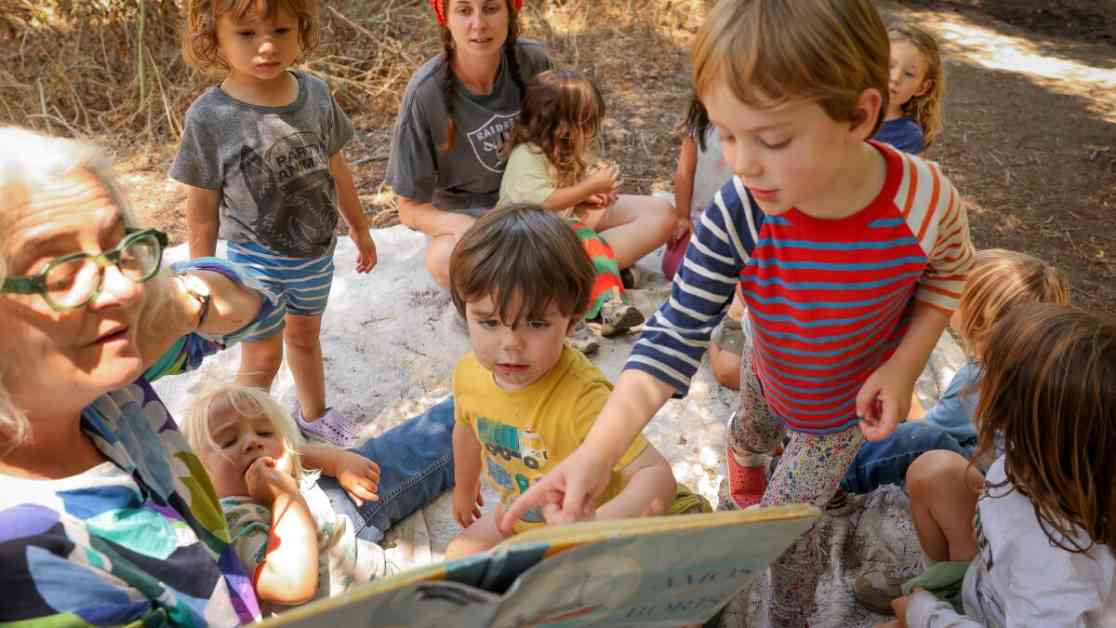Forest Schools: Transforming Children’s Relationship with Nature and Technology
On a beautiful summer day in eastern Orange County, a preschooler named Roger found himself teetering on rocks by a creek, unsure if he could make it back to where his classmates and caregivers were waiting. A volunteer youth mentor with Earthroots Field School extended her hand, offering reassurance to the 3-year-old. With a firm grasp, Roger took one confident step towards her, then another. “There we go!” someone called out as he successfully cleared the burbling waterway.
This act of pushing boundaries and learning to balance on rocks without immediate parental intervention is a fundamental aspect of nature-based education, as explained by Angela Capps, a teacher at Earthroots Field School. This school is just one example of a growing number of early education providers that are grounded in the natural world.
Nature-based education, also known as forest schools, nature preschools, or outdoor kindergartens, operates on the simple premise that children benefit greatly from spending a significant portion of their day outdoors. According to David Sobel, professor emeritus at Antioch University New England and author of “Beyond Ecophobia: Reclaiming the Heart in Nature Education,” researchers have found that nature-based learning supports creativity, resiliency, executive function, school readiness, and a multitude of other benefits for both the body and mind.
The concept of forest schools, which originated in Scandinavia and made its way to the U.S. in the 1960s, has seen a significant surge in popularity in recent years. This growth can be attributed to concerns about children becoming too immersed in the virtual world and the rising mental health crisis among youth. The COVID-19 pandemic further accelerated this trend, with school closures prompting parents to seek safe outdoor learning environments for their preschoolers.
As of the last school year, there were approximately 800 nature preschools in the U.S., marking a 200% increase since 2017, according to a survey by the nonprofit Natural Start Alliance, which advocates for access to nature-based early childhood education. California ranks among the top three states with the highest number of nature schools, primarily catering to children aged 3 to 5.
Proponents of nature-based education argue that children who are immersed in nature tend to be happier, healthier, and potentially the next generation of environmental stewards. By fostering an early connection to the natural world, educators hope to instill a sense of love and responsibility towards the environment in young learners.
Lia Grippo, president of the California Association of Forest Schools, emphasizes the importance of cultivating a deep connection to nature in children. She states, “We only protect that which we love. If we want children to grow into adults who can address the challenges we have created for them, they must have a profound love for the land they inhabit.”
While the forest school movement is filled with optimism and shows no signs of slowing down, it faces several challenges. Many programs operate without licenses, making them ineligible for public funding and potentially limiting access to families who cannot afford tuition. Additionally, the lack of diversity within nature preschools remains a pressing issue, with white children comprising 78% of student bodies compared to roughly 47% of the U.S. population. Latino and Black children are notably underrepresented, highlighting the need for greater inclusivity in these programs.
Addressing racial disparities in nature education has become a priority for many educators. The creation of the Black Educator Network, an Alliance-affiliated professional community for Black educators in nature-based early education, is a step towards promoting diversity and equity within the field.
Many nature-based education programs focus on preschool-aged children, aiming to provide meaningful experiences in nature early in a child’s life. The flexibility and less stringent regulations of early education settings make it easier to innovate and incorporate outdoor learning into the curriculum.
One of the key goals of nature-based education is to develop environmental literacy among children. This involves instilling an understanding of environmental issues, fostering a sense of care for the planet, and equipping young learners with the skills needed to address environmental challenges.
Jodi Levine, executive director of Earthroots Field School, emphasizes the importance of helping children develop a deep appreciation for nature. Rather than directly discussing complex topics like climate change with young learners, the focus is on helping children “fall in love with nature” and understand its beauty and value to prevent its destruction.
Becca Hackett-Levy, founder and director of Northeast L.A. Forest School, believes that learning about climate change can begin from a very young age. By immersing children in nature and allowing them to observe the impact of human activities on the environment, educators can lay the foundation for environmental awareness and stewardship.
Nature schools also provide opportunities for children to experience environmental phenomena firsthand. Last year, a group of children had to evacuate from Elysian Park due to a brush fire, prompting discussions about the effects of climate change and human activities on the environment. These real-life experiences help children develop a deeper understanding of environmental issues and the importance of taking care of the planet.
While the forest school movement continues to grow and evolve, it faces challenges related to licensing and regulatory frameworks. Many nature schools operate without licenses, either due to operating hours or the number of children they serve. This lack of licensing can limit access to public funding and raise concerns about the safety and quality of education provided by these programs.
Some educators advocate for a pathway to licensing for nature schools, while others fear that regulatory requirements may hinder the innovative and nature-centered approach of these programs. There is also the concern that regulations could impact activities like tree climbing, which are seen as essential for developing resilience and overcoming challenges in nature.
As the landscape of education and environmental awareness evolves, nature schools continue to adapt and teach valuable lessons to children. Despite challenges related to licensing and safety, the benefits of nature-based education in fostering environmental literacy, resilience, and a deep connection to the natural world are undeniable.
In a world where children are increasingly surrounded by screens and technology, forest schools offer a refreshing alternative that encourages exploration, creativity, and a sense of wonder in the great outdoors. By providing young learners with meaningful experiences in nature, these programs are shaping the next generation of environmental stewards and fostering a lifelong love for the planet.



























